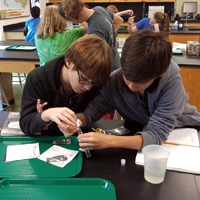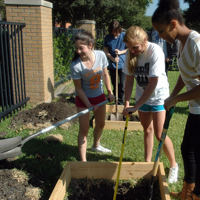Tag: environmental science
The Environmental Science class at Lakehill is learning how to grow a healthy, all-natural garden in their own backyard. It is not uncommon for students in urban and suburban areas to be unfamiliar and somewhat intimidated with the concept of growing your own food. I want to show them just how easy it is.
They are learning simple methods to keep unwanted insects, rabbits, birds, and other animals out of their gardens; how to determine what vegetables will grow well in a garden at different times of the year in this region; how to compost scraps, and how to determine soil health and replenish agents that the soil needs to remain productive. I also want them to gain a sense of pride for building something that is useful in their own homes, and that can have tremendous health, environmental, and economic benefits if enough people get involved.
The AP Environmental Science class visited the McCommas Bluff Landfill that serves the Dallas community. I think many of them expected to see heaping piles of trash and worried that they would gag from the odor as we approached the gate. In fact, there was no odor until we drove up to an active cell where trashed was being stuffed into the ground by enormous Earth-moving tractors.
The outlying scenery was littered not with trash, but with lush vegetation highlighted by a wide-open view of the Dallas skyline. Even the mound of trash was more like an oddly-placed plateau with small roads carved along the perimeter and covered with grass on nearly every slope. If not for the the pipes and wells poking out of the ground every 30 feet or so (and the dozens of trash-toting trucks) you might easily be convinced that it was a nature preserve.
Speaking of the pipes and wells, we learned that these are for capturing methane (which gets cleaned in an area that looks like a mini-refinery before being sent off to the power grid for production of electricity) and carbon dioxide, and for injecting bacteria-laden juice into the cell of trash to speed up decomposition.
One thing we didn’t see, but were told existed at the bottom of each cell, is a sandwich of clay-plastic liner-clay-plastic liner that prevents any of that “trash juice” from seeping into the ground water. In fact, there are a series of pumps and pipes that flush the percolated trash juice into a holding tank where it is diluted and pumped into other cells to keep on working.
It is really fascinating to see all of the technology in place at our local landfill, and comforting to know that they have plans to increase its efficiency in the near future. Aside from the implementation of technology to reduce land-consumption for trash disposal, there are also plans to increase waste diversion from 30% to 70% in the near future. In other words, about 30% of all trash deposited (by mass) at McCommas is either recycled, mulched, or composted, and there are plans to increase that number to 70%.
Oh, and that methane– enough is captured every year to supply more than 90,000 Dallas homes with clean energy. Overall, it was a eye-opening experience rather than a nose-pinching one!

